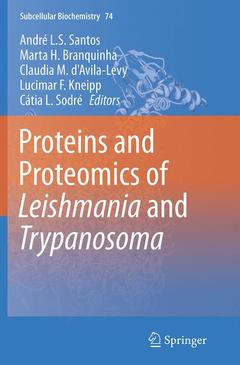Description
Proteins and Proteomics of Leishmania and Trypanosoma, Softcover reprint of the original 1st ed. 2014
Subcellular Biochemistry Series, Vol. 74
Coordinators: Santos André L.S., Branquinha Marta H., d’Avila-Levy Claudia M., Kneipp Lucimar F., Sodré Cátia L.
Language: English
Subjects for Proteins and Proteomics of Leishmania and Trypanosoma:
Keywords
Chemotherapy; Leishmania; Protein; Proteomic; Trypanosoma; infectious diseases
Proteins and Proteomics of Leishmania and Trypanosoma
Publication date: 09-2016
Support: Print on demand
Publication date: 09-2016
Support: Print on demand
Proteins and Proteomics of Leishmania and Trypanosoma
Publication date: 12-2013
381 p. · 15.5x23.5 cm · Hardback
Publication date: 12-2013
381 p. · 15.5x23.5 cm · Hardback
Description
/li>Contents
/li>Comment
/li>
This book contains a collection of critical reviews on the expression of biologically functional proteins in Leishmania and Trypanosoma, which was written by renowned researchers on this field. Species belonging to these trypanosomatids? genera are etiological agents of leishmaniasis, Chagas? disease and sleeping sickness that are extremely debilitating human infection diseases, which remain a major health problem especially in countries from Latin America, Africa and Middle East. Substantiating the problem, the currently accepted drugs for these diseases are quiet unsatisfying due to their low efficacy and high toxicity. In order to solve these real problems, several research groups around the world have become involved in the study and identification of novel potential targets in the trypanosomatid cell. Since proteins are key macromolecules involved in crucial metabolic processes of all living cells, studies have focused on the expression of specific proteins produced by Leishmania and Trypanosoma by means of different biochemical, molecular and proteomic approaches in order to explore them as targets for understanding the parasite life cycle and developing new strategies against trypanosomiasis. With these proposals in mind, the book ?Proteins and Proteomics of Leishmania and Trypanosoma? encompasses (i) an integrated view about the biochemistry of parasites belonging to the Leishmania and Trypanosoma genera; (ii) an updated review on the expression of biologically relevant proteins by human pathogenic trypanosomatids and their possible role in the interaction with host cells/molecules as well as a target for development of both alternative chemotherapies and vaccine; and (iii) several pictures, diagrams and tables that can be used to illustrate both undergraduate and postgraduate teaching as well as scientific lectures, being a useful resource for students andresearchers.
Preface.- Biology of Human Pathogenic Trypanosomatids: Epidemiology, Lifecycle and Ultrastructure.- Selection of Molecular Targets for Drug Development against Trypanosomatids.- A2 and other visceralizing proteins of Leishmania: role in pathogenesis and application for vaccine development.- Arginase in Leishmania.- The heat shock proteins of Trypanosoma cruzi.- The Gp82 Surface Molecule of Trypanosoma cruzi Metacyclic Forms.- The Gp85 Surface Glycoproteins from Trypanosoma cruzi.- Trypanosoma cruzi Trans-Sialidase: Structural Features and Biological Implications.- Surface Topology Evolution of Trypanosoma Trans-Sialidase.- Ecto-Nucleotidases and Ecto-Phosphatases from Leishmania and Trypanosoma Parasites.- Gp63 Function in the Interaction of Trypanosomatids with the Invertebrate Host – Facts and Prospects.- Highlights on Trypanosomatid Aminoacyl-tRNA Synthesis.- The Expected Outcome of the Trypanosoma cruzi Proteomic Map: a Review of its Potential Biological Applications for Drug Target Discovery.- Proteomics advances in the study of Leishmania parasites and leishmaniasis.- Towards the Phosphoproteome of Trypanosomatids. Index.
The book presents an integrated view about the biochemistry of parasites belonging to the Leishmania and Trypanosoma genera The book contains an updated review on the expression of biologically relevant proteins by human pathogenic trypanosomatids and their possible role in the interaction with host cells The chapters contain several pictures, diagrams and tables that can be used to illustrate both undergraduate and postgraduate teaching as well as scientific lectures
© 2024 LAVOISIER S.A.S.




